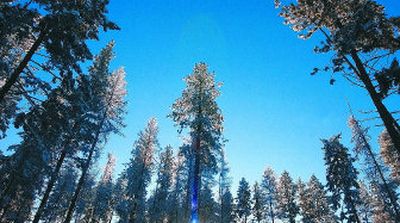Here comes the sun!

The winter solstice took place last week. It was the shortest day of the year, when the Inland Northwest saw only eight hours and 25 minutes of sunlight.
Winter solstice is a turning point. In the Northern Hemisphere, it is the day that the sun reaches its lowest point in the southern sky at solar noon. Last Wednesday it reached that at 10:35 a.m. PST. From this date on, until the summer solstice in June, the sun will rise in the sky a little each day.
The term “solstice” comes from the Latin word “solstitium.” “Sol” means sun and “stitium” means a stoppage. Ancient sun watchers observed that around the time of the solstice the sun’s elevation at noon appeared to be the same for several days before and after the solstice. It appeared to stop so hence the term.
Our current knowledge of astronomy and technology makes it very easy to get exact information on the times of the solstices, equinoxes and sunrise and sunset. Modern astronomers have calculated them precisely and they are available from any one of a dozen sources in print or on the Internet. To many people their passing through the year is no more than a curiosity.
But before the invention of the telescope, the calendar and precise measuring instruments took away some of the mystery, the occurrence of the solstice, particularly the winter solstice, was an extremely important event to many ancient cultures. Without the instruments and knowledge of modern astronomy, ancient societies could only observe what they saw happening in the sky and interpret it using their current knowledge.
They knew from their observations that the passing of the winter solstice marked a major change in the cycle of the year. Rather than being controlled by a series of astronomical laws, they attributed the occurrence to the interaction of gods of nature, of good and evil, and supernatural forces.
Out of these beliefs grew unique religions with elaborate ceremonies and rituals that were meant to show appreciation for and appease the gods and forces of nature. Sun observers/priests were held in high esteem in their communities.
They built elaborate temples like Stonehenge and many others to celebrate the coming and going of the sun. Many of the temples were in reality sun observatories so carefully laid out that on the day of the winter solstice, and only on that day, a shaft of sunlight would hit a stone deep inside the structure. This signaled the beginning of the celebrations.
Times have changed and our knowledge of modern astronomy has removed the mystery behind these beliefs.
Charles Ross of the Spokane office of the National Weather Service says it is the interaction of the Earth spinning around the sun and the angle at which the sun hits the Earth during its yearly cycle that creates solstice and equinox.
The Earth doesn’t go around the sun in a perfectly straight position with the poles straight up and down to the sun. Rather the poles are at an angle. As a result as it moves in its orbit the sun hits it at different angles through its rotations.
“The Earth’s orbit is inexact,” says Ross. “Because the Earth’s orbit is longer [than the calendar year] you are going to see shifts in the longest and shortest days and the equinox of the year. The time it takes Earth to go around the sun is actually almost a quarter of a day longer [than the calendar].”
Ross adds that we correct for most of this extra time by adding a day to the calendar during leap year. “It gets things close but it’s still not perfect.”
This little bit of excess time does however vary enough that it changes the actual times of the solstices, equinoxes and sunset and sunrise times. Sometimes there is more of it and at other times a little less. As an example the 2005 winter solstice on Dec. 21 was at 10:35 a.m. In 2006, it will be at 12:22 a.m. on Dec. 22.